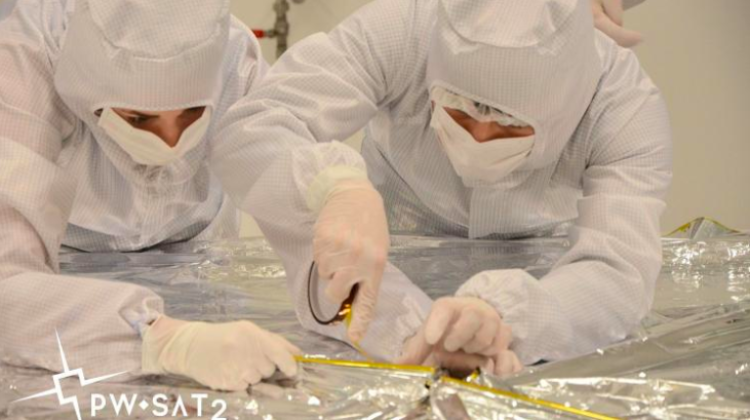The launch of student satellite PW-Sat2 scheduled planned for November 19
 Source: Warsaw University of Technology
Source: Warsaw University of Technology
The satellite PW-Sat2 built by Warsaw University of Technology students is scheduled to be launched into orbit on November 19. It will be carried by the Falcon 9 rocket launched from California (USA). The most important task of PW-Sat2 will be to test the deorbitation sail.
The PW-Sat2 satellite built by members of the Students Space Association at Warsaw University of Technology will be launched into space with the mission SSO-A from the Vandenberg base in the United States. It will reach an altitude of 575 km on the SpaceX rocket Falcon 9. It will be the fourth Polish satellite in space, and the second satellite built at the Warsaw University of Technology.
Constructors of the satellite want to fly to the US to see the PW-Sat2 launch with their own eyes. They have already raised the funds for eight people, but - they argue - many more people who have worked on the satellite deserve to experience this event. That`s why they have organized a fundraiser for the trip.
As part of its mission, PW-Sat2 will perform a total of four experiments. The most important of them will be testing the deorbitation sail. The deorbitation system will shorten the satellite`s lifetime in orbit from over 15 years to a dozen months. This is an important invention in the context of the growing problem of space debris. Thanks to the solution, future satellites, after completing their mission, would cease to transform into dangerous debris threatening, for example, astronauts on the International Space Station (ISS).
As we read in a release sent to PAP, the deorbitation sail was made of a mylar film about ten times thinner than a human hair. Its prototype was tested under conditions of weightlessness and low pressure in the Bremen Drop Tower (Germany). The diameter of the rolled sail is about 8 cm, which is important due to the possibility of using this solution in microsatellites. The sail, when opened in orbit, will be 2 × 2 meters. PW-Sat2 is a CubeSat satellite - it has a rectangular shape measuring 10x10x22 cm, and the sail takes up less than 25 percent of its volume.
"Opening the sail will significantly increase the surface area of the satellite, and thus the aerodynamic resistance, which will decelerate the satellite in a low orbit around the Earth. After the remaining three experiments are completed, the satellite will open the sail, which will gradually lower its orbit and, consequently, it will burnt in the Earth`s atmosphere" - says Inna Uwarowa, the project coordinator quoted in the release message.
Another experiment will be related to the determination of PW-Sat2`s position in orbit, which will be enabled by a solar sensor. This sensor can be used in the future in other satellites for spatial orientation. Thanks to this instrument, the solar panels of the satellites using the sensor can be optimally positioned relative to the light source.
The satellite also has two cameras that will register the process of opening the deorbitation sail. This will allow to verify the correct opening of the sail. The fourth experiment is the solar panel deployment mechanism designed by students. Solar cells are the basic source of energy for the on-board computer and PW-Sat2 devices.
As part of the SSO-A mission, 48 other CubeSats (miniature satellites) and 15 microsatellites will be launched into space together with the PW-Sat2. After the rocket enters the orbit, satellites will be gradually released PW-Sat2 will be the second satellite to be pushed out from the container it will share with the German MOVE-II satellite, and then its basic subsystems will be launched. During the first 40 minutes of radio silence, basic data from the satellite subsystems will be collected.. Then the antennas will open and an attempt will be made to stabilize the satellite`s rotation. The PW-Sat2 mission will continue for 40 days.
The contract for the launch of the satellite was signed in October 2016 by the Warsaw University of Technology and Innovative Space Logistics B.V. The students worked on the satellite in the cleanroom of the Space Research Centre of the Polish Academy of Sciences and at the Centre for Advanced Materials and Technologies CEZAMAT. Earlier, over many months, they designed and developed their solutions at the Warsaw University of Technology Innovation Management and Technology Transfers Centre. The strategic partners of the student project are the Gliwice companies Future Processing and FP Instruments.
A team composed of students from various faculties of Warsaw University of Technology started working on the PW-Sat2 satellite in 2013. Over 5 years, more than 100 people took part in the PW-Sat2 project. Earlier, in February 2012, the first Polish satellite PW-Sat, also built by students of Warsaw University of Technology, was launched into orbit. Active contact with the satellite lasted about half a year after it was put in orbit, after which the satellite went into complete hibernation. One of its subsystems failed, which contributed to the difficulty of receiving the command to open the deorbitation tail by the satellite. The constructors of the second satellite assure that PW-Sat2 will be ready to deal with such a failure and carry out its mission automatically, even in the event of loss of communication with the satellite. (PAP)
author: Ewelina Krajczyńska
ekr/ agt/ kap/
tr. RL
Przed dodaniem komentarza prosimy o zapoznanie z Regulaminem forum serwisu Nauka w Polsce.















